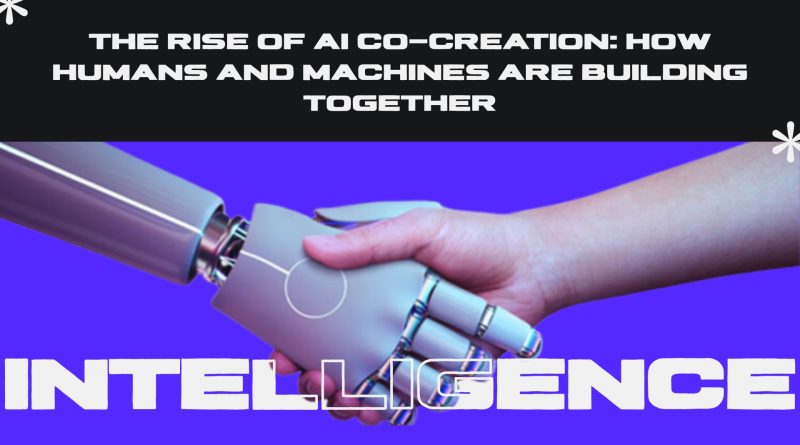Ai Co-Creation : How Humans and Machines Are Building Together
Introduction
In recent years, the landscape of creativity and innovation has seen a profound shift. This transformation is largely driven by the rise of artificial intelligence (AI) and its ability to collaborate with humans in unprecedented ways. This phenomenon—known as AI co-creation—combines the cognitive strengths of both humans and machines. As a result, it leads to groundbreaking products, services, and artistic expressions.
Moreover, as technology continues to evolve, the boundaries between human ingenuity and machine intelligence are beginning to blur. This opens up new possibilities for collaboration across various fields, from art and design to healthcare and engineering. In this article, we explore the journey of AI co-creation—its foundations, real-world applications, and ethical considerations. Ultimately, we’ll reflect on how this partnership can help us thrive together in the future.
What is AI co-creation?
AI co-creation refers to the collaborative effort where humans and machines work together to generate ideas, solve problems, and innovate. By combining human intuition with machine precision, this approach fosters faster and more imaginative outcomes.
How is AI co-creation being applied in various industries?
AI co-creation is being embraced in various fields, such as art, design, healthcare, and engineering. In the realm of art, AI tools assist artists in generating fresh ideas; in healthcare, AI plays a role in drug discovery and tailoring medicine to individual needs; and in engineering, AI enhances product design using generative algorithms.
The Significance of Teamwork in Innovation
Innovation flourishes through teamwork. When people come together, they share ideas, viewpoints, and a touch of unpredictability. Now, introduce AI into the equation, and you have a formidable blend of creativity and efficiency. This partnership enables quick prototyping, immediate problem-solving, and insights that could take humans a long time to uncover independently.
Machine Learning and Natural Language Processing
Machine learning serves as the intellect behind AI co-creation—it empowers machines to learn from data and enhance their capabilities over time. If AI were a pupil, ML would undoubtedly be its favorite class. Conversely, Natural Language Processing (NLP) allows machines to comprehend and mimic human language, making interactions with our digital friends quite seamless (well, most of the time).
Generative Design and Content Creation Tools
Picture a computer that can generate designs, graphics, or even full musical compositions based on a few prompts. Generative design and content creation tools facilitate this kind of enchanting collaboration. By leveraging algorithms that can assess countless options, these tools empower designers and creators to venture into new creative territories.
Robotics and Automation in Co-Creation
Robots are not merely here to clean your floors (sorry Roomba). They are evolving into vital collaborators in creative and productive tasks across various sectors.
Advantages of AI Co-Creation Across Different Sectors
Boosted Efficiency and Productivity
Picture a scenario where you can hand off the monotonous tasks—such as data entry, analysis, and scheduling—to your ever-reliable AI assistant. Sounds fantastic, doesn’t it? In fields like manufacturing and logistics, AI is already optimizing operations, minimizing human errors, and accelerating processes.
Enhanced Creativity and Innovation
The era of waiting for inspiration to strike in a quiet room is over. Welcome AI, the digital inspiration that examines trends and proposes ideas based on extensive datasets. In sectors like marketing and design, AI tools can create original concepts or variations, providing human creators with a springboard for their next major innovation.
Customization and User Experience
In the era of personalized recommendations like “You might also enjoy,” AI co-creation is revolutionizing how businesses tailor user experiences. By examining user habits and preferences, AI systems can assist in customizing products and services to cater to individual needs, crafting a unique experience that feels incredibly special.
Frequently Asked Questions (FAQ)
How is AI co-creation being implemented in different industries?
AI co-creation is being employed in various fields, such as art, design, healthcare, and engineering. In the realm of art, AI tools assist artists in generating fresh ideas; in healthcare, AI plays a role in drug discovery and personalized medicine; and in engineering, AI enhances product design using generative algorithms.
What ethical issues are associated with AI co-creation?
Ethical issues encompass job displacement, biases in AI systems, and intellectual property rights. As AI becomes increasingly woven into creative processes, it is crucial to tackle these challenges to promote fair and responsible technology use.
What does the future look like for collaboration between humans and machines?
The future of collaboration between humans and machines appears bright, with advancements in AI technology likely to strengthen the relationship between people and machines. As we adjust to these developments, we can look forward to new possibilities for innovation, creativity, and improved problem-solving skills across all sectors.
